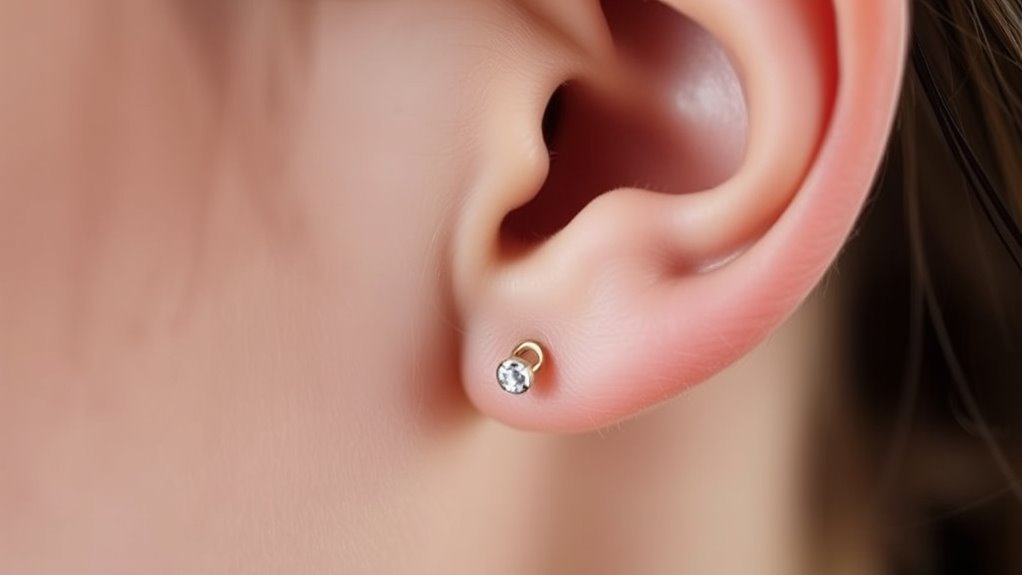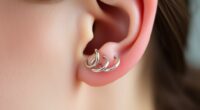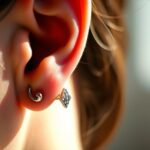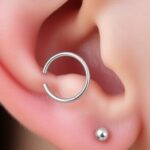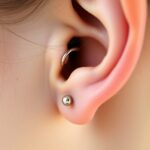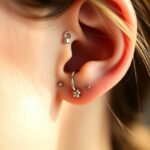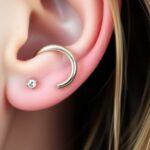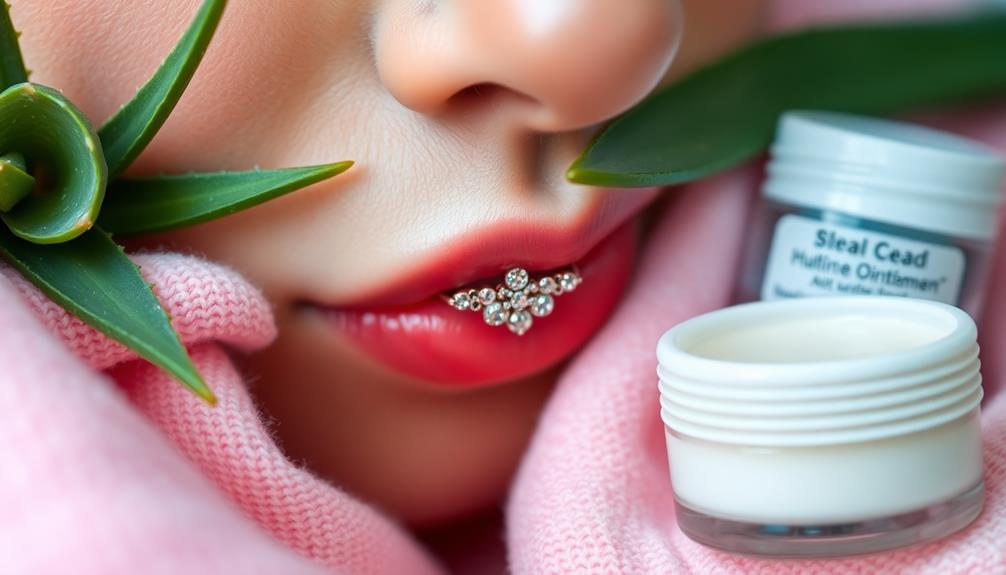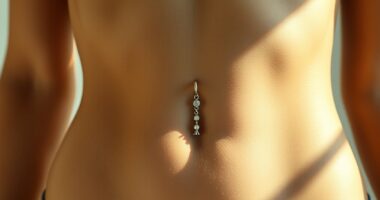A conch piercing sits centrally in your ear’s cartilage, making it a versatile spot for various jewelry styles. You can choose simple studs during healing or switch to hoops, captive beads, or bold dangles afterward. Its placement allows for both subtle and statement looks, perfect for experimentation. Proper care keeps your piercing healthy and stylish. To discover all the options for placement, jewelry choices, and styling tips, keep exploring what this trendy piercing has to offer.
Key Takeaways
- Located centrally in the ear’s cartilage, the conch offers a prominent yet versatile placement for various styles.
- Healing takes 6-12 months, requiring proper aftercare like saline cleaning and avoiding unnecessary touching.
- Jewelry options include studs during healing and hoops, captive beads, or dangles post-healing, made from high-quality materials.
- The spacious conch area allows for bold or minimal styles, enabling personalization and creative expression.
- Regular jewelry maintenance and proper cleaning prevent infections and ensure long-term enjoyment of the piercing.
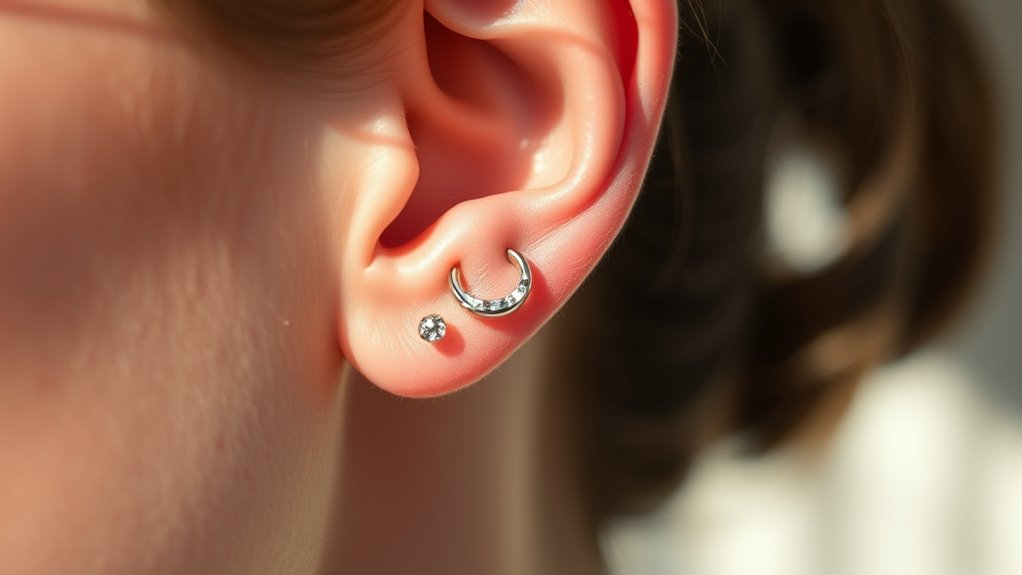
If you’re considering a bold and stylish ear piercing, a conch piercing might be the perfect choice. This type of piercing is placed in the middle of your ear’s cartilage, offering a unique look that stands out without being overly flashy. Before you get pierced, it’s essential to understand what the healing process involves and how to properly care for your jewelry. The healing process usually takes anywhere from 6 to 12 months, depending on how well you follow aftercare instructions. During this time, expect some swelling, tenderness, and maybe a bit of crusting around the piercing site. To promote healing, keep your hands away from the piercing, avoid touching it unnecessarily, and follow your piercer’s advice on cleaning routines. Using a saline solution to gently cleanse the area twice daily helps prevent infection and speeds up recovery. Jewelry maintenance is equally important once the piercing has healed. You should regularly check that your jewelry is secure but not too tight, as loose jewelry can cause irritation or migration. When cleaning, avoid harsh chemicals or alcohol-based solutions, which can dry out the skin and irritate the piercing. Instead, stick with a saline soak or a piercing-specific cleaning solution recommended by your piercer. If you notice any signs of infection—such as excessive redness, swelling, pain, or pus—reach out to your piercer or a healthcare professional promptly. Proper jewelry maintenance also involves choosing high-quality materials like surgical steel, titanium, or niobium, which are less likely to cause allergic reactions or irritation. As for jewelry options, you can opt for simple studs during the healing phase, but once healed, you have the freedom to explore more elaborate designs like hoops, captive beads, or decorative dangles. The conch provides a spacious area, so you can experiment with different styles and sizes to match your personality or wardrobe. When styling your conch piercing, consider the overall look you want to achieve, whether it’s minimal and elegant or bold and edgy. Because of its central location, a conch piercing makes a statement whether you wear a single piece or multiple accessories. Just remember that the right jewelry can both enhance your style and keep your piercing healthy, so choose wisely and take good care of your new piercing to enjoy it for years to come.
Frequently Asked Questions
How Long Does a Conch Piercing Take to Fully Heal?
A conch piercing typically takes about 6 to 12 months to fully recover. During this healing timeline, you should follow proper piercing aftercare to prevent infection and promote healing. Keep the area clean, avoid touching or rotating the jewelry unnecessarily, and steer clear of irritants. Everyone’s healing process varies, so be patient and consistent with your aftercare routine to ensure a healthy, fully healed conch piercing.
Are There Any Activities to Avoid During Healing?
Ever imagine your healing conch piercing getting irritated by careless activities? You should avoid strenuous activities, swimming, and sleeping on the pierced side to prevent complications. During healing, follow hygiene tips like cleaning with saline solution and avoiding touching your jewelry with dirty hands. These activity restrictions help your piercing heal faster and reduce the risk of infection. Don’t let unnecessary movements or dirty environments sabotage your healing process!
What Are the Signs of an Infected Conch Piercing?
If you notice redness, swelling, increased pain, or discharge that’s yellow or green, these are signs of infection during your healing process. You might also feel warmth around the piercing or see pus. Keep an eye on these symptoms and avoid touching or irritating the area. If symptoms worsen or persist, see a professional to prevent complications and guarantee proper healing.
Can I Change Jewelry Immediately After Piercing?
You shouldn’t change jewelry immediately after getting your conch piercing. During initial healing, which can take several months, your piercing needs time to settle and avoid irritation. Wait until it’s fully healed before considering a jewelry change. When you do switch, choose jewelry that’s appropriate for healing and matches your style. Rushing this step can cause swelling, infection, or delay healing, so be patient and consult your piercer for guidance.
Are Conch Piercings Suitable for Sensitive Skin?
Think of your skin as a delicate garden; conch piercings can suit sensitive skin if you choose hypoallergenic materials like surgical steel or titanium. These options minimize irritation and support proper piercing aftercare. Always listen to your body, and avoid changing jewelry too soon. With gentle care and high-quality materials, your conch piercing can heal beautifully without sparking discomfort or allergic reactions.
Conclusion
Your conch piercing is more than just jewelry—it’s a gateway to self-expression and a symbol of your unique story. Like a secret melody echoing in your ear, it holds personal meaning and style. As you choose your placement and jewelry, remember you’re crafting a piece of art that reflects your inner voice. Embrace it fully, knowing your piercing is a shining beacon of your individuality, forever resonating like a silent song only you can hear.
Piecing together a life one day at a time, that’s me. I’m Rusty, and I love being editor-in-chief of creative piercing. It’s my passion to help others see their vision and bring it to life. When I’m not working or taking care of my family, you can find me reading a good book or eating pie (of course!).

